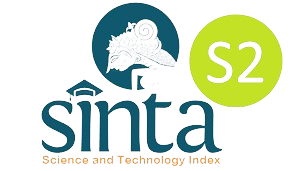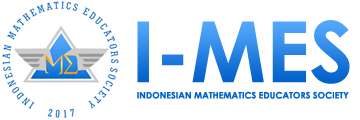How mathematical disposition shapes computational thinking in solving systems of linear equations: A flowchart-supported qualitative study
DOI:
https://doi.org/10.29408/jel.v11i4.32082Keywords:
computational thinking skills, flowchart-supported, mathematical dispositionAbstract
Computational thinking (CT) is a vital 21st-century skill in mathematics education, enabling students to solve problems systematically through decomposition, pattern recognition, abstraction, and algorithmic thinking. However, students’ mathematical disposition—encompassing beliefs, habits of mind, and affective tendencies—may significantly influence CT development. Guided by the affective–cognitive interaction model, this study aimed to explore how mathematical disposition shapes students’ CT skills, particularly in solving systems of three-variable linear equations using self-constructed, flowchart-supported algorithmic representations. A descriptive qualitative approach was adopted, with six students (two each from high, medium, and low disposition levels, identified via questionnaire) participating. Data collection involved a disposition scale, CT test, interviews, and documentation. Findings revealed that high-disposition students successfully demonstrated all CT indicators and produced coherent flowcharts. Medium-disposition students showed variability: some met all criteria, while others faltered in algorithmic design. Low-disposition students managed only basic decomposition and pattern recognition, with incomplete abstraction and fragmented flowcharts. These results suggest a strong link between affective factors and cognitive performance in CT tasks. Implications highlight the importance of integrating disposition-aware scaffolding—such as interactive visual tools and guided reflection—to support diverse learners and enhance CT development in mathematics classrooms.
References
Angeli, C. (2022). The effects of scaffolded programming scripts on pre-service teachers’ computational thinking: Developing algorithmic thinking through programming robots. International Journal of Child-Computer Interaction, 31. https://doi.org/10.1016/j.ijcci.2021.100329
Azizia, A. J., Kusmaryono, I., Maharani, H. R., & Arifuddin, A. (2023). Students’ computational thinking process in solving PISA problems of change and relationship content reviewed from students’ self efficacy. EduMa: Mathematics Education Learning and Teaching, 12(1), 112–125. https://doi.org/10.24235/eduma.v12i1.13132
Azizia, A. J., Masrukan, & Susilo, B. E. (2024). Systematic literature review: Trends computational thinking and mathematical disposition in mathematics learning. Kontinu: Jurnal Penelitian Didaktik Matematika, 8(2), 152–169. https://doi.org/10.53115/19975996_2024_02_083_092
Azmi, R. D., & Ummah, S. K. (2021). Implementasi project based learning untuk mengeksplorasi kemampuan computational thinking mahasiswa [Implementation of project-based learning to explore students' computational thinking skills. Jurnal Ilmiah Pendidikan Matematika Al Qalasadi, 5(1), 52–61. https://doi.org/10.32505/qalasadi.v5i1.2761
Begum, S., Flowers, N., Tan, K., Carpenter, D. M. H., & Moser, K. (2021). Promoting literacy and numeracy among middle school students: Exploring the mediating role of self-efficacy and gender differences. International Journal of Educational Research, 106, 101722. https://doi.org/10.1016/j.ijer.2020.101722
Calao, L. A., Moreno-León, J., Correa, H. E., & Robles, G. (2015). Developing mathematical thinking with scratch an experiment with 6th grade students. In K. J, K. T, R. Christoph, C. G, & L. É (Eds.), Lecture Notes in Computer Science (including subseries Lecture Notes in Artificial Intelligence and Lecture Notes in Bioinformatics (Vol. 9307, pp. 17–27). Springer Verlag. https://doi.org/10.1007/978-3-319-24258-3_2
Chinofunga, M. D., Chigeza, P., & Taylor, S. (2025). How can procedural flowcharts support the development of mathematics problem-solving skills? Mathematics Education Research Journal, 37(ue 1)). https://doi.org/10.1007/s13394-024-00483-3
Clark, J. M., & Paivio, A. (1991). Dual coding theory and education. Educational Psychology Review, 3(3), 149–210. https://doi.org/10.1007/BF01320076
Cromley, J. G., & Chen, R. (2024). Instructional support for visual displays: An updated literature review. Technology, Knowledge and Learning, 29(3), 1191–1205. https://doi.org/10.1007/s10758-023-09699-x
Doleck, T., Bazelais, P., Lemay, D. J., Saxena, A., & Basnet, R. B. (2017). Algorithmic thinking, cooperativity, creativity, critical thinking, and problem solving: exploring the relationship between computational thinking skills and academic performance. Journal of Computers in Education, 4(4), 355–369. https://doi.org/10.1007/s40692-017-0090-9
Doloma, D., Kambas, A., Aggeloussis, N., & Michalopoulou, M. (2020). A longitudinal study for the relationship between motor coordination and body mass index in primary school children. International Journal of Instruction, 13(3), 511–524. https://doi.org/10.29333/iji.2020.13335a
Elicer, R., Tamborg, A. L., Bråting, K., & Kilhamn, C. (2023). Comparing the integration of programming and computational thinking into Danish and Swedish elementary mathematics curriculum resources. Iron and Steel Technology, 11(3), 77–102. https://doi.org/10.31129/LUMAT.11.3.1940
Fanchamps, N. L. J. A., Slangen, L., Hennissen, P., & Specht, M. (2021). The influence of SRA programming on algorithmic thinking and self-efficacy using Lego robotics in two types of instruction. International Journal of Technology and Design Education, 31(2), 203–222. https://doi.org/10.1007/s10798-019-09559-9
Firmasari, S., Nopriana, T., & Pujiana, F. (2025). Computational thinking Skills from the perspective of students’ self-confidence in mathematics learning. Indonesian Research Journal in Education| IRJE, 9(01), 509–525. https://doi.org/10.22437/irje.v9i01.37228
Fleur, D. S., Bredeweg, B., & Bos, W. (2021). Metacognition: ideas and insights from neuro- and educational sciences. Npj Science of Learning, 6(1), 1–13. https://doi.org/10.1038/s41539-021-00089-5
Hariyani, L., Yurniwati, Y., & Utami, A. D. (2024). The effect of discovery learning in mathematics learning on computational thinking in terms of self-regulated learning (SRL) in student. Jurnal Elementaria Edukasia, 7(2), 2801–2814. https://doi.org/10.31949/jee.v7i2.9551
Isharyadi, R., & Juandi, D. (2023). A systematics literature review of computational thinking in mathematics education: Benefits and challenges. Formatif: Jurnal Ilmiah Pendidikan MIPA, 13(1), 69–80. https://doi.org/10.30998/formatif.v13i1.15922
Jong, M. S. Y., Geng, J., Chai, C. S., & Lin, P. Y. (2020). Development and predictive validity of the computational thinking disposition questionnaire. Sustainability (Switzerland, 12(11). https://doi.org/10.3390/su12114459
Kamak, L. P., & Mago, V. (2023). Assessing the impact of using python to teach computational thinking for remote schools in a blended learning environment. In Z. P, I. A, & I. A (Eds.), LNCS (Vol. 14041, pp. 482–500). Springer Science and Business Media Deutschland GmbH. https://doi.org/10.1007/978-3-031-34550-0_35
Kayhan, O., Korkmaz, Ö., & Çakır, R. (2024). How do computational thinking and logical and math thinking skills predict programming self-efficacy? Computers in the Schools, 41(1), 51–73. https://doi.org/10.1080/07380569.2023.2220696
Kusmaryono, I., Suyitno, H., Dwijanto, D., & Dwidayati, N. (2019). The effect of mathematical disposition on mathematical power formation: review of dispositional mental functions. International Journal of Instruction, 12(1), 343–356. https://doi.org/https://eric.ed.gov/?id=EJ1201186
Lee, S. W. Y., Tu, H. Y., Chen, G. L., & Lin, H. M. (2023). Exploring the multifaceted roles of mathematics learning in predicting students’ computational thinking competency. International Journal of STEM Education, 10(1). https://doi.org/10.1186/s40594-023-00455-2
Maharani, S., Nusantara, T., As'ari, A. R., & Qohar, A. (2019). How the students computational thinking ability on algebraic? International Journal of Scientific and Technology Research, 8(9), 419–423.
Mertens, A. J., & Colunga, E. (2025). Assessing cognitive components of computational thinking. Frontiers in Psychology, 16. https://doi.org/10.3389/fpsyg.2025.1434453
Muhammad, I., Rusyid, H. K., Maharani, S., & Angraini, L. M. (2023). Computational thinking research in mathematics learning in the last decade: A bibliometric review. International Journal of Education in Mathematics, Science and Technology, 12(1), 178–202. https://doi.org/10.46328/ijemst.3086
NCTM. (2000). Principles and standards for school mathematics. The National Council of Teachers of Mathematics, Inc.
Nordby, S. K., Bjerke, A. H., & Mifsud, L. (2022). Computational thinking in the primary mathematics classroom: A systematic review. Digital Experiences in Mathematics Education, 8(1), 27–49. https://doi.org/10.1007/s40751-022-00102-5
Pérez, A. (2018). A framework for computational thinking dispositions in mathematics education. Journal for Research in Mathematics Education, 49(4), 424–461. https://doi.org/10.5951/jresematheduc.49.4.0424
Psycharis, S., & Kotzampasaki, E. (2019). The impact of a STEM inquiry game learning scenario on computational thinking and computer self-confidence. Eurasia Journal of Mathematics, Science and Technology Education, 15(4), 1689. https://doi.org/10.29333/ejmste/103071
Rahman, M. M., Sharker, M. H., & Paudel, R. (2020, 2020). An effective approach to teach an introductory computer science course with computational thinking and flow-chart based visual programming Proceedings - Frontiers in Education Conference, FIE, http://dx.doi.org/10.1109/FIE44824.2020.9273930
Ramaila, S., & Shilenge, H. (2023). Integration of computational thinking activities in Grade 10 mathematics learning. International Journal of Research in Business and Social Science, 12(2), 458–471. https://doi.org/10.20525/ijrbs.v12i2.2372
Reiser, B. J. (2018). Scaffolding complex learning: The mechanisms of structuring and problematizing student work. Scaffolding: A Special Issue of the Journal of the Learning Sciences, 13(3), 273–304. https://doi.org/10.4324/9780203764411-2
Romero, M., & Ouellet, H. (2016). Scaffolding digital game design activities grouping older adults, younger adults and teens. In Z. J & S. G (Eds.), Lecture Notes in Computer Science (including subseries Lecture Notes in Artificial Intelligence and Lecture Notes in Bioinformatics (Vol. 9754, pp. 74–81). Springer Verlag. https://doi.org/10.1007/978-3-319-39943-0_8
Ryan, R. M., & Deci, E. L. (2000). Intrinsic and extrinsic motivations: Classic definitions and new directions. Contemporary Educational Psychology, 25(1), 54–67.
Schraw, G., & Richmond, A. S. (2022). Using visual displays to improve classroom thinking. Educational Research: Theory and Practice, 33(2), 80–102. https://doi.org/https://eric.ed.gov/?id=EJ1352339
Sezer, H. B., & Namukasa, I. K. (2023). School and community practices of computational thinking in mathematics education through diverse perspectives. Journal of Research in Science, Mathematics and Technology Education, 6(SI), 137–160. https://doi.org/10.31756/jrsmte.617si
Silverman, D. (2021). Doing qualitative research.
Solitro, U., Pasini, M., Gradi, D., & Brondino, M. (2017). A preliminary investigation on computational abilities in secondary school. In H. A & D. V (Eds.), Lecture Notes in Computer Science (including subseries Lecture Notes in Artificial Intelligence and Lecture Notes in Bioinformatics (Vol. 10696, pp. 169–179). Springer Verlag. https://doi.org/10.1007/978-3-319-71483-7_14
Suarsana, I. M., Herman, T., Nurlaelah, E., Irianto, & Pacis, E. R. (2024). Computational thinking in mathematics education across five nations. Indonesian Journal of Educational Research and Review, 7(1), 26–35. https://doi.org/10.23887/ijerr.v7i1.68202
Supiarmo, M. G., Mardhiyatirrahmah, L., & Turmudi, T. (2021). Pemberian scaffolding untuk memperbaiki proses berpikir komputasional siswa dalam memecahkan masalah matematika [Providing scaffolding to improve students' computational thinking processes in solving mathematical problems. Jurnal Cendekia : Jurnal Pendidikan Matematika, 5(1), 368–382. https://doi.org/10.31004/cendekia.v5i1.516
Supiarmo, M. G., Sholikin, N. W., Harmonika, S., & Gaffar, A. (2022). Implementasi pembelajaran matematika realistik untuk meningkatkan kemampuan berpikir komputasional siswa [Implementation of realistic mathematics learning to improve students' computational thinking skills. Numeracy, 9(1), 1–13. https://doi.org/10.46244/numeracy.v9i1.1750
Tang, Y., & Ma, X. (2023, 2023). Can computational thinking contribute to EFL learning and teaching? Proceedings - 2023 International Conference on Artificial Intelligence and Education, ICAIE 2023, http://dx.doi.org/10.1109/ICAIE56796.2023.00016
Threekunprapa, A., & Yasri, P. (2020). Unplugged coding using flowblocks for promoting computational thinking and programming among secondary school students. International Journal of Instruction, 13(3), 207–222. https://doi.org/10.29333/iji.2020.13314a
Wang, L. (2023). The impact of student-centered learning on academic motivation and achievement: A comparative research between traditional instruction and student-centered approach. Journal of Education, Humanities and Social Sciences, 22, 346–353. https://doi.org/10.54097/ehss.v22i.12463
Wardani, S. S., Susanti, R. D., & Taufik, M. (2022). Implementasi pendekatan computational thinking melalui game jungle adventure terhadap kemampuan problem solving [Implementation of computational thinking approach through jungle adventure games on problem solving skills. SJME (Supremum Journal of Mathematics Education, 6(1), 1–13. https://doi.org/10.35706/sjme.v6i1.5430
Weintrop, D., Beheshti, E., Horn, M., Orton, K., Jona, K., Trouille, L., & Wilensky, U. (2016). Defining computational thinking for mathematics and science classrooms. Journal of Science Education and Technology, 25, 127–147. https://doi.org/10.1007/s10956-015-9581-5
Wing, J. (2017). Computational thinking’s influence on research and education for all. Italian Journal of Educational Technology, 25(2), 7–14. https://doi.org/https://www.learntechlib.org/p/183466/
Zan, R., Brown, L., Evans, J., & Hannula, M. S. (2006). Affect in mathematics education: An introduction. Educational Studies in Mathematics, 63(2), 113–121. https://doi.org/https://www.jstor.org/stable/25472116
Zhang, J. H., Meng, B., Zou, L. C., Zhu, Y., & Hwang, G. J. (2023). Progressive flowchart development scaffolding to improve university students’ computational thinking and programming self-efficacy. Interactive Learning Environments, 31(6), 3792–3809. https://doi.org/10.1080/10494820.2021.1943687
Downloads
Published
How to Cite
Issue
Section
License
Copyright (c) 2025 Ananda Jullailatul Azizia, Masrukan, Bambang Eko Susilo, Ahmad Arifuddin

This work is licensed under a Creative Commons Attribution-ShareAlike 4.0 International License.
Authors who publish with the Jurnal Elemen agree to the following terms:
- Authors retain copyright and grant the journal right of first publication with the work simultaneously licensed under Creative Commons Attribution-ShareAlike 4.0 International License (CC BY-SA 4.0).
- Authors are able to enter into separate, additional contractual arrangements for the distribution of the journal's published version of the work (e.g., post it to an institutional repository or publish it in a book), with an acknowledgment of its initial publication in this journal.
- Authors are permitted and encouraged to post their work online (e.g., in institutional repositories or on their website) prior to and during the submission process, as it can lead to productive exchanges, as well as earlier and greater citation of published work.
Jurnal Elemen is licensed under a Creative Commons Attribution-ShareAlike 4.0 International License





